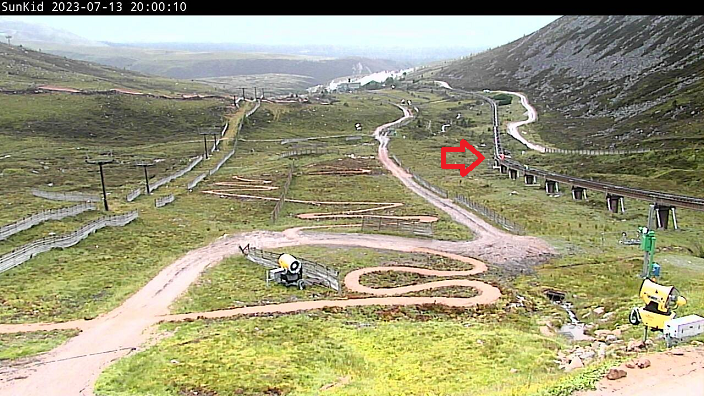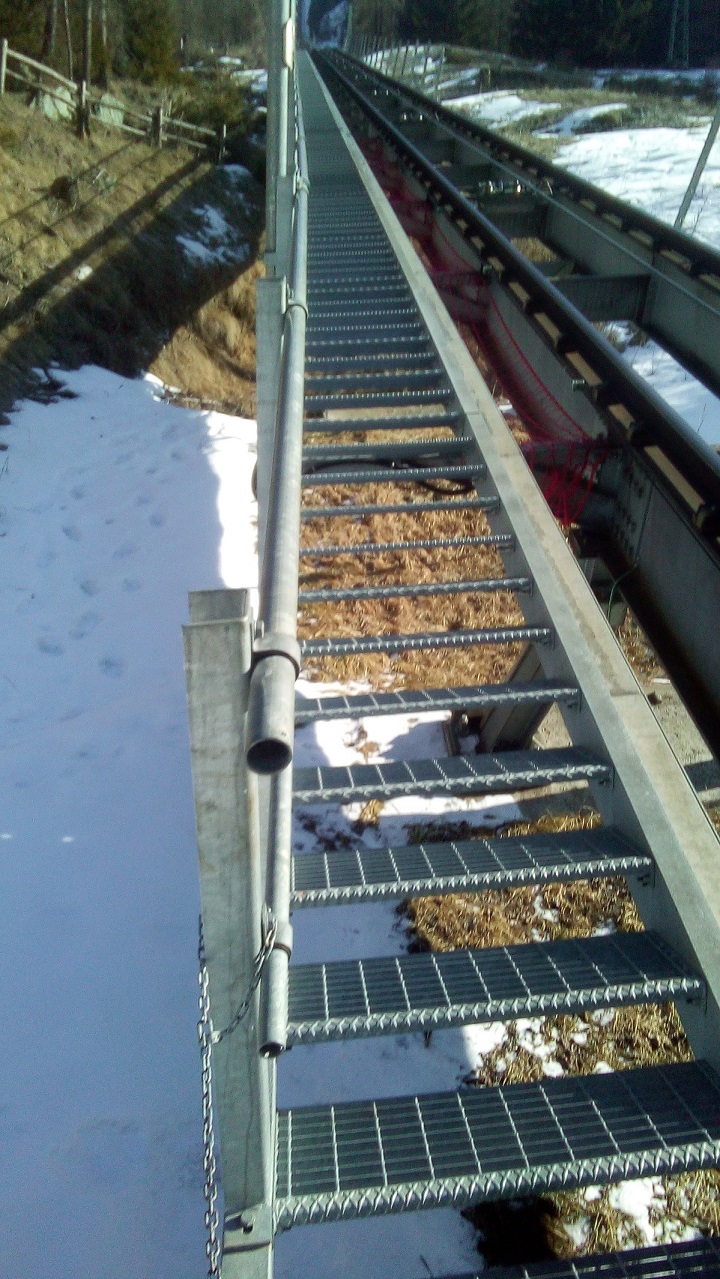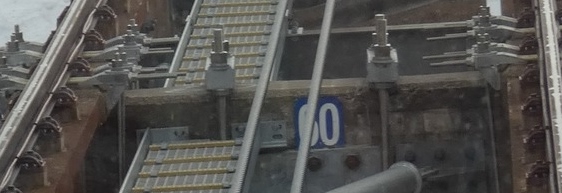
This post considers a number of outstanding concerns about the safety of the funicular at Cairn Gorm and HIE’s response. The context for this is HIE has never given a proper explanation for the failure of the funicular and without that information it is not possible to tell how long the repairs might work or how long the funicular will be safe to use. In addition it is clear the funicular was re-opened before all repairs were complete as currently the funicular is being closed at least a day a week to enable “finishing work”:

I have identified three concerns about the structural safety of the funicular to date.
(a) That the concrete “I” beams are not strong enough for the length of the span (I was made aware of this by a person with 36 years experience in this line of work). This would appear to be confirmed by the steel work around the “I” beams (see top photo), although HIE has never explained the reason for this;
(b) Related to this, the COWI report of December 2018 stated “The precast beams are reinforced but not pre-stressed”. I am grateful to an academic lecturer in railways for informing me that the minimum depth for a concrete “I” beam which is not pre-stressed should be 8cm for every 1m length. That means the safe depth of the “I” beam is therefore 8 x 18 = 144cm not the actual 80cm! This figure may be for current standards and not those from 1999 but the conclusion is that after the funicular failed all the beams should either have been replaced or strengthened along their whole length in order to comply with today’s standards.
One option to do this would be to use a Carbon Fibre Reinforced Polymer wrap, as explained by this company:


Would this option have been more suitable to extend the safe working life of the funicular? I have consulted a civil engineering company who seem to think so.
(c) Continued movement of some of the beams. A previous post on Parkswatch reported the movement of a beam AFTER the strengthening works (see here).
Correspondence with HIE about these safety concerns
On Friday 09/06/2023 a letter (see here) was sent to Stuart Black CEO of HIE outlining these concerns for both staff and passengers and making the following additional points:
“(1) If a concrete “I” beam actually fails there could at the very least be injuries to passengers. If a beam totally collapses the rest of the beams above that point could also be dragged off their bearings.
(2) In the event of even a simple breakdown there is no escape walkway for passengers who could, and have been in the past, trapped for a considerable time, and,
(3) If further fractures appear, the cost implications would be significant.
I have been trying to find out from the various bodies responsible for health and safety what information they have in specific regard to the safety of the whole structure without success. I would request therefore that you would confirm HIE is confident that the structure is safe to use and, if so, provide the information you have that supports this.”
I received the following reply from HIE:-
“The design and implementation of the strengthening programme for the funicular viaduct was implemented and checked repeatedly by COWI and independent design checker Mott MacDonald – both of them world leading specialist bridge engineers.
Following completion of reinstatement works towards the end of 2022, a senior official from the authorised technical body for the Department for Transport conducted both a rigorous document review and physical inspection of the Cairngorm funicular viaduct and control system.
The inspector’s conclusions were positive and enabled the Department, through the UK Secretary of State for Transport, to authorise the safety cases, providing clearance and assurance for the funicular service to resume safe operations in January 2023.
I hope the above response provides reassurance about your concerns.”
Well actually no it doesn’t!
“Experts” have been wrong in the past and will be in the future, so only time will tell.
But to go back to the escape walkway (item (2) in the letter to Stuart Black), notice how in their reply HIE have ignored this point. In a follow up email the question was asked again – and again ignored!
This is important because the Health & Safety Executive (HSE) acknowledged the concerns about the maintenance walkway as far back as 26/01/2021, i.e before HIE obtained their expert reports:-
“HSE have not physically inspected this cableway for some time as it was voluntarily taken out of use for repairs. I can confirm that we are in regular contact with the operators and keeping abreast of the repair / reinstatement plans. The walkway is for both inspection and as an escape route in case of breakdown, and is therefore an integral and vital part of the installation. We will verify safety provisions during the repair works, and I can confirm that reinstatement of the walkway will be completed before the installation is finally recommissioned for passenger traffic.”

And at Cairn Gorm:

What has now been installed on the Cairn Gorm funicular, a walkway between the tracks, may be acceptable for maintenance but is completely unsuitable as an escape route in case of breakdown as there is no access to the walkway from the train. Therefore if stranded, customers and staff would be stuck!
The views of the HSE suggest the re-opening of the funicular should not have been approved as there appears to be no means in place for safe evacuation of passengers. Should the funicular now be closed until the HSE agree that a safe means of evacuation, for both staff and passengers, is in place?

There is too much political and reputational capital tied up in the funicular to admit failings.
OK, I see the HIE response saying that they are relying on the engineering experts they have employed to ensure that the repairs are ‘safe’, but that’s what HIE appeared to do when the funicular was originally designed and built – and now it appears that HIE is pursuing the original designer and builder through the Courts for alleged mistakes. If HIE and the engineering companies it has employed to investigate the structural failure and design and construct the repairs are so sure they are correct in their investigations and calculations, why doesn’t HIE publish all the repair design calculations to ‘prove’ they are correct and enable a peer review of the work? What have they got to lose………?
The only technical work that I have seen that has been published is the original COWI investigation into the structural failure. That report, however, only describes the symptoms of the structural failure, but does not properly address the cause. Thus to repeat, to date HIE and its engineers seem to have only treated the symptoms (in a bodged way – using the words of another Parkswatch reader with H&S experience of oil rigs) but has not addressed the cause of the failure.
There is another issue in the design of this funicular which is that all but about three of the support pillars are not secured to bedrock. Consequently most of the funicular is ‘floating’ on the boulder clay and glacial till in the Coire Cas corrie. There is plenty of geomorphological evidence that boulder clay and glacial till can and does move very large and heavy rocks down mountain slopes. All but three or so of these pillar structures are ‘floating’ and thus cannot fully resist the downward movement of glacial material and the associated groundwater. The result – the base of the pillar moves downhill under the massive pressure of the surrounding glacial material and the pillar tilts leaning uphill – exactly what was observed with the dozens of failed pillar structures. in my view making the pillar foundations more massive and/or applying struts (as carried out in the repairs) will not solve the problem and the pillar rotation with recur.
Anyway, its only public money that is being squandered to save the face of the HIE Board and it’s executives!
I agree that the Cairngorms walkway is not suitable for the evacuation of passengers in the event of the blocking of cars due to a funicular incident.